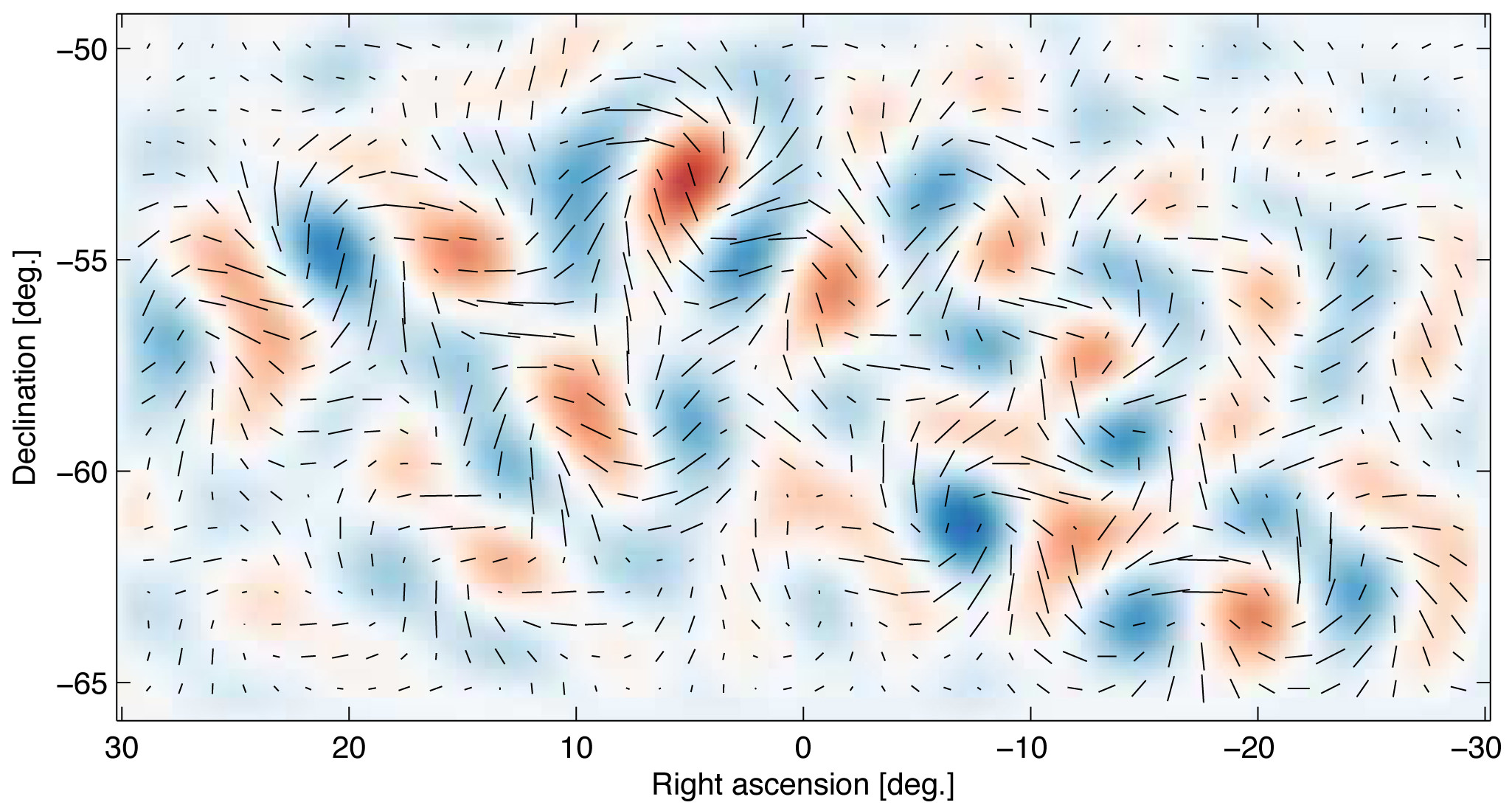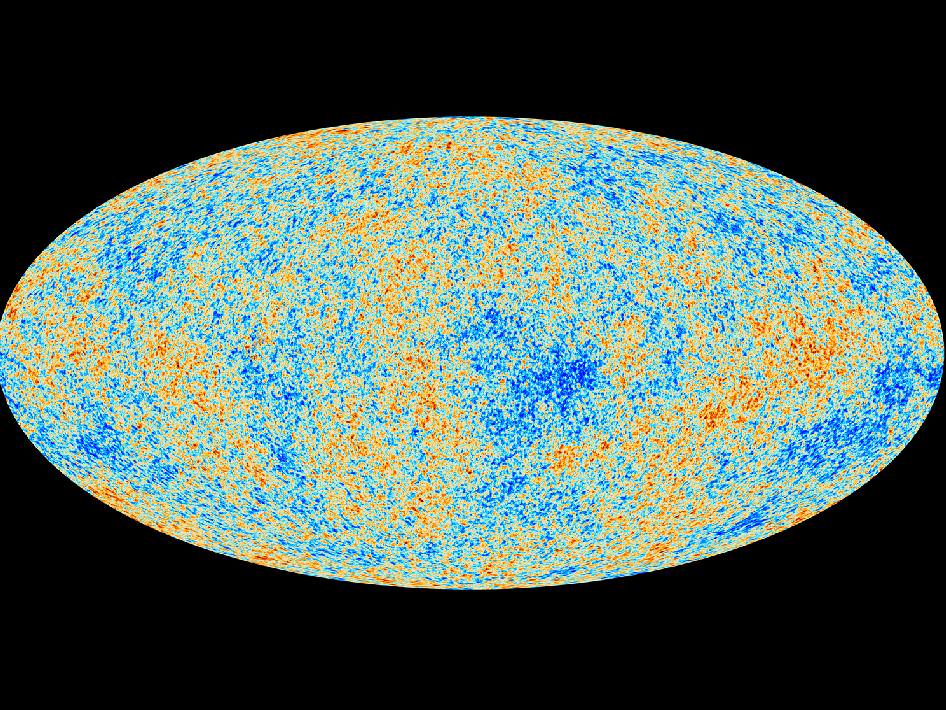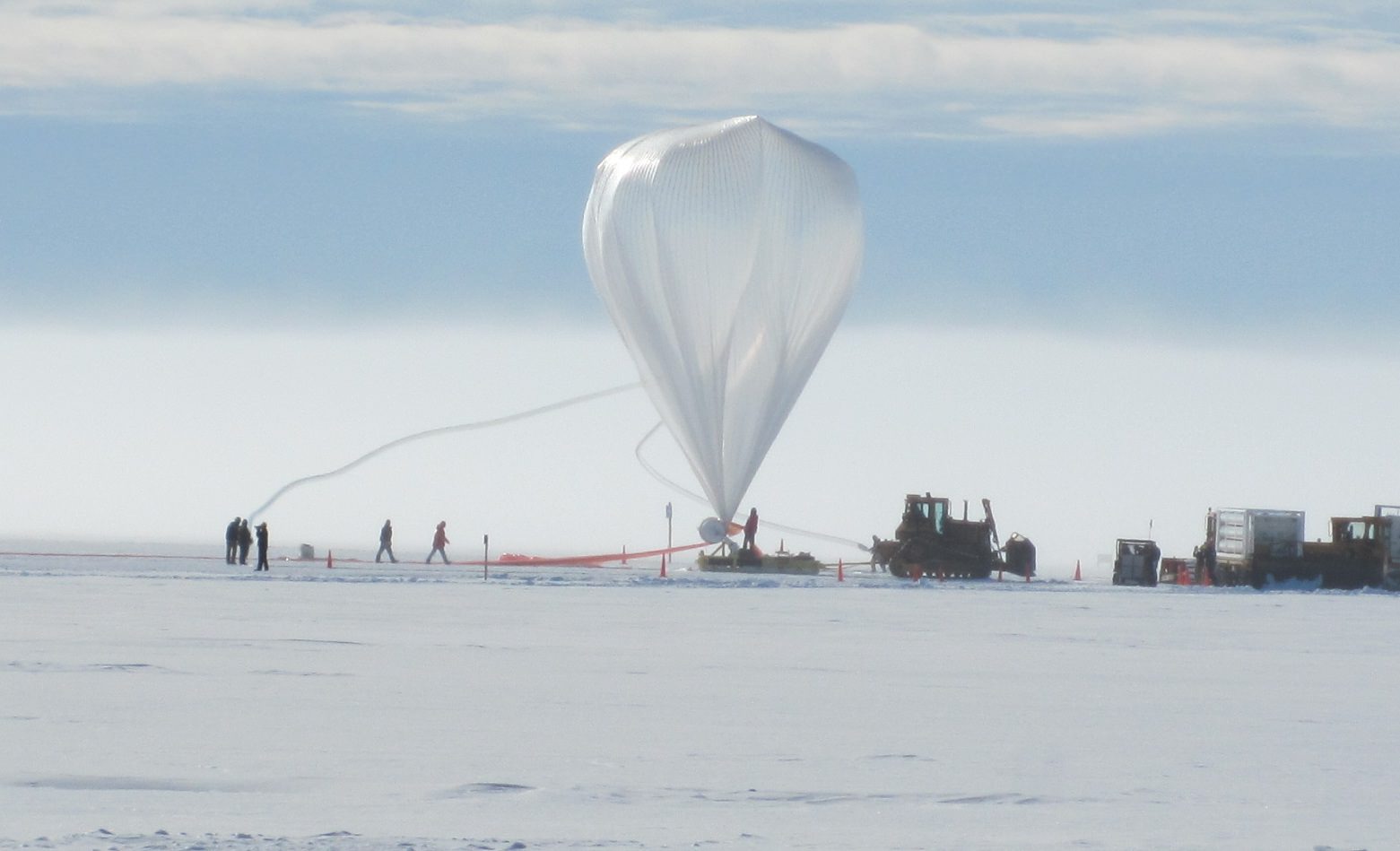The gravitational wave background was first detected in 2016. It was announced following the release of the first data set from the European Pulsar Timing Array. A second set of data has just been released and, joined by the Indian Pulsar Timing Array, both studies confirm the existence of the background. The latest theory seems to suggest that we’re seeing the combined signal of supermassive black hole mergers.
Continue reading “More Evidence for the Gravitational Wave Background of the Universe”Finally an Answer to why Gamma Rays are Coming From Seemingly Empty Space
Gamma rays strike Earth from all directions of the sky. Our planet is bathed in a diffuse glow of high-energy photons. It doesn’t affect us much, and we don’t really notice it, because our atmosphere is very good at absorbing gamma rays. It’s so good that we didn’t notice cosmic gamma rays until the 1960s when gamma-ray detectors were launched into space to look for signs of atomic weapons tests. Even then, what we noticed were intense flashes of gamma rays known as gamma ray bursts.
Continue reading “Finally an Answer to why Gamma Rays are Coming From Seemingly Empty Space”Beyond “Fermi’s Paradox” V: What is the Aestivation Hypothesis?

Welcome back to our Fermi Paradox series, where we take a look at possible resolutions to Enrico Fermi’s famous question, “Where Is Everybody?” Today, we examine the possibility that the reason we’re not hearing from aliens is that they’re asleep and waiting for the Universe to get better.
In 1950, Italian-American physicist Enrico Fermi sat down to lunch with some of his colleagues at the Los Alamos National Laboratory, where he had worked five years prior as part of the Manhattan Project. According to various accounts, the conversation turned to aliens and the recent spate of UFOs. Into this, Fermi issued a statement that would go down in the annals of history: “Where is everybody?“
This became the basis of the Fermi Paradox, which refers to the high probability estimates for the existence of extraterrestrial intelligence (ETI) and the apparent lack of evidence. But despite seventy years of looking, we still haven’t been able to answer Fermi’s question, leading to multiple proposals as to why this is. Today, we look at the “Aestivation Hypothesis,” which argues that aliens are not dead (or non-existent), they’re just resting!
Continue reading “Beyond “Fermi’s Paradox” V: What is the Aestivation Hypothesis?”How We’ve ‘Morphed’ From “Starry Night” to Planck’s View of the BICEP2 Field

From the vantage point of a window in an insane asylum, Vincent van Gogh painted one of the most noted and valued artistic works in human history. It was the summer of 1889. With his post-impressionist paint strokes, Starry Night depicts a night sky before sunrise that undulates, flows and is never settled. Scientific discoveries are revealing a Cosmos with such characteristics.
Since Vincent’s time, artists and scientists have taken their respective paths to convey and understand the natural world. The latest released images taken by the European Planck Space Telescope reveals new exquisite details of our Universe that begin to touch upon the paint strokes of the great master and at the same time looks back nearly to the beginning of time. Since Van Gogh – the passage of 125 years – scientists have constructed a progressively intricate and incredible description of the Universe.

The path from Van Gogh to the Planck Telescope imagery is indirect, an abstraction akin to the impressionism of van Gogh’s era. Impressionists in the 1800s showed us that the human mind could interpret and imagine the world beyond the limitations of our five senses. Furthermore, optics since the time of Galileo had begun to extend the capability of our senses.
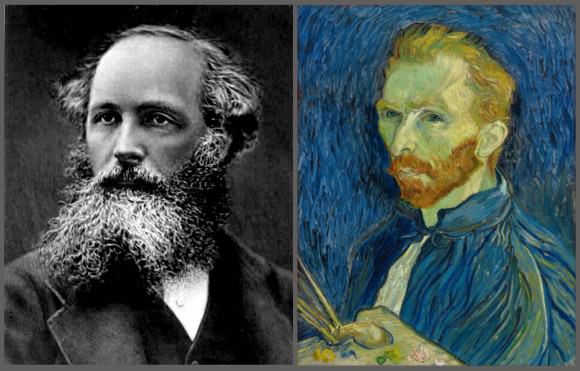
Mathematics is perhaps the greatest form of abstraction of our vision of the World, the Cosmos. The path of science from the era of van Gogh began with his contemporary, James Clerk Maxwell who owes inspiration from the experimentalist Michael Faraday. The Maxwell equations mathematically define the nature of electricity and magnetism. Since Maxwell, electricity, magnetism and light have been intertwined. His equations are now a derivative of a more universal equation – the Standard Model of the Universe. The accompanying Universe Today article by Ramin Skibba describes in more detail the new findings by Planck Mission scientists and its impact on the Standard Model.
The work of Maxwell and experimentalists such as Faraday, Michelson and Morley built an overwhelming body of knowledge upon which Albert Einstein was able to write his papers of 1905, his miracle year (Annus mirabilis). His theories of the Universe have been interpreted, verified time and again and lead directly to the Universe studied by scientists employing the Planck Telescope.
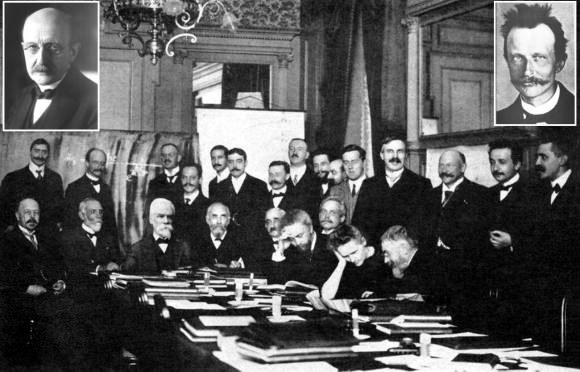
In 1908, the German physicist Max Planck, for whom the ESA telescope is named, recognized the importance of Einstein’s work and finally invited him to Berlin and away from the obscurity of a patent office in Bern, Switzerland.
As Einstein spent a decade to complete his greatest work, the General Theory of Relativity, astronomers began to apply more powerful tools to their trade. Edwin Hubble, born in the year van Gogh painted Starry Night, began to observe the night sky with the most powerful telescope in the World, the Mt Wilson 100 inch Hooker Telescope. In the 1920s, Hubble discovered that the Milky Way was not the whole Universe but rather an island universe, one amongst billions of galaxies. His observations revealed that the Milky Way was a spiral galaxy of a form similar to neighboring galaxies, for example, M31, the Andromeda Galaxy.
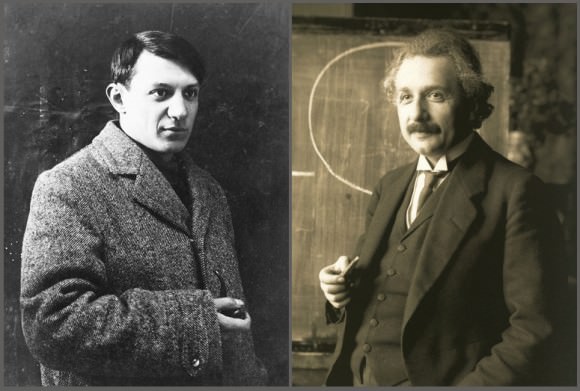
Einstein’s equations and Picasso’s abstraction created another rush of discovery and expressionism that propel us for another 50 years. Their influence continues to impact our lives today.
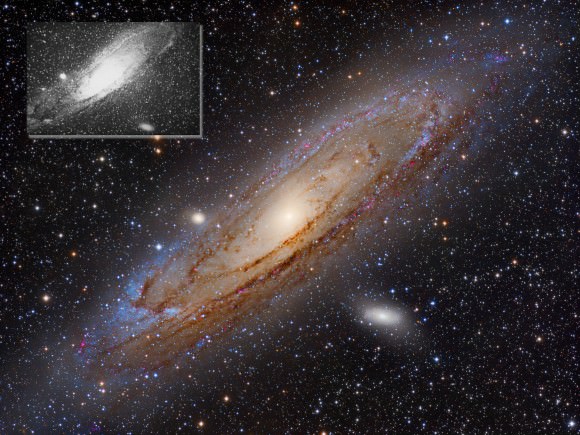
Telescopes of Hubble’s era reached their peak with the Palomar 200 inch telescope, four times the light gathering power of Mount Wilson’s. Astronomy had to await the development of modern electronics. Improvements in photographic techniques would pale in comparison to what was to come.
The development of electronics was accelerated by the pressures placed upon opposing forces during World War II. Karl Jansky developed radio astronomy in the 1930s which benefited from research that followed during the war years. Jansky detected the radio signature of the Milky Way. As Maxwell and others imagined, astronomy began to expand beyond just visible light – into the infrared and radio waves. Discovery of the Cosmic Microwave Background (CMB) in 1964 by Arno Penzias and Robert Wilson is arguably the greatest discovery from observations in the radio wave (and microwave) region of the electromagnetic spectrum.
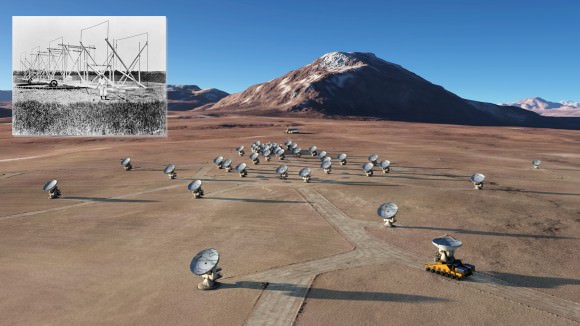
Analog electronics could augment photographic studies. Vacuum tubes led to photo-multiplier tubes that could count photons and measure more accurately the dynamics of stars and the spectral imagery of planets, nebulas and whole galaxies. Then in the 1947, three physicists at Bell Labs , John Bardeen, Walter Brattain, and William Shockley created the transistor that continues to transform the World today.
For astronomy and our image of the Universe, it meant more acute imagery of the Universe and imagery spanning across the whole electromagnetic spectrum. Infrared Astronomy developed slowly beginning in the 1800s but it was solid state electronics in the 1960s when it came of age. Microwave or Millimeter Radio Astronomy required a marriage of radio astronomy and solid state electronics. The first practical millimeter wave telescope began operations in 1980 at Kitt Peak Observatory.

With further improvements in solid state electronics and development of extremely accurate timing devices and development of low-temperature solid state electronics, astronomy has reached the present day. With modern rocketry, sensitive devices such as the Hubble and Planck Space Telescopes have been lofted into orbit and above the opaque atmosphere surrounding the Earth.
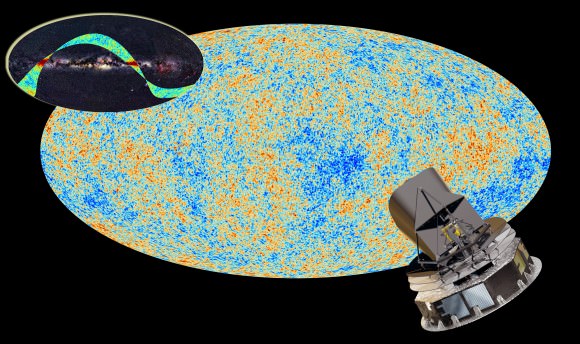
Astronomers and physicists now probe the Universe across the whole electromagnetic spectrum generating terabytes of data and abstractions of the raw data allow us to look out into the Universe with effectively a sixth sense, that which is given to us by 21st century technology. What a remarkable coincidence that the observations of our best telescopes peering through hundreds of thousands of light years, even more so, back 13.8 billion years to the beginning of time, reveal images of the Universe that are not unlike the brilliant and beautiful paintings of a human with a mind that gave him no choice but to see the world differently.
Now 125 years later, this sixth sense forces us to see the World in a similar light. Peer up into the sky and you can imagine the planetary systems revolving around nearly every star, swirling clouds of spiral galaxies, one even larger in the sky than our Moon, and waves of magnetic fields everywhere across the starry night.
Consider what the Planck Mission is revealing, questions it is answering and new ones it is raising – It Turns Out Primordial Gravitational Waves Weren’t Found.
We’ve Discovered Inflation! Now What?
Days like these make being an astrophysicist interesting. On the one hand, there is the annoucement of BICEP2 that the long-suspected theory of an inflationary big bang is actually true. It’s the type of discovery that makes you want to grab random people off the street and tell them what an amazing thing the Universe is. On the other hand, this is exactly the type of moment when we should be calm, and push back on the claims made by one research team. So let’s take a deep breath and look at what we know, and what we don’t.

First off, let’s dispel a few rumors. This latest research is not the first evidence of gravitational waves. The first indirect evidence for gravitational waves was found in the orbital decay of a binary pulsar by Russell Hulse and Joseph Taylor, for which they were awarded the Nobel prize in 1993. This new work is also not the first discovery of polarization within the cosmic microwave background, or even the first observation of B-mode polarization. This new work is exciting because it finds evidence of a specific form of B-mode polarization due to primordial gravitational waves. The type of gravitational waves that would only be caused by inflation during the earliest moments of the Universe.
It should also be noted that this new work hasn’t yet been peer reviewed. It will be, and it will most likely pass muster, but until it does we should be a bit cautious about the results. Even then these results will need to be verified by other experiments. For example, data from the Planck space telescope should be able to confirm these results assuming they’re valid.
That said, these new results are really, really interesting.

What the team did was to analyze what is known as B-mode polarization within the cosmic microwave background (CMB). Light waves oscillate perpendicular to their direction of motion, similar to the way water waves oscillate up and down while they travel along the surface of water. This means light can have an orientation. For light from the CMB, this orientation has two modes, known as E and B. The E-mode polarization is caused by temperature fluctuations in the CMB, and was first observed in 2002 by the DASI interferometer.
The B-mode polarization can occur in two ways. The first way is due to gravitational lensing. The first is due to gravitational lensing of the E-mode. The cosmic microwave background we see today has travelled for more than 13 billion years before reaching us. Along its journey some of it has passed close enough to galaxies and the like to be gravitationally lensed. This gravitational lensing twists the polarization a bit, giving some of it a B-mode polarization. This type was first observed in July of 2013. The second way is due to gravitational waves from the early inflationary period of the universe. As inflationary period occurred, then it produced gravitational waves on a cosmic scale. Just as the gravitational lensing produces B-mode polarization, these primordial gravitational waves produce a B-mode effect. The discovery of primordial wave B-mode polarization is what was announced today.
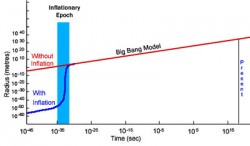
Inflation has been proposed as a reason for why the cosmic microwave background is as uniform as it is. We see small fluctuations in the CMB, but not large hot or cold spots. This means the early Universe must have been small enough for temperatures to even out. But the CMB is so uniform that the observable universe must have been much smaller than predicted by the big bang. However, if the Universe experienced a rapid increase in size during its early moments, then everything would work out. The only problem was we didn’t have any direct evidence of inflation.
Assuming these new results hold up, now we do. Not only that, we know that inflation was stronger than we anticipated. The strength of the gravitational waves is measured in a value known as r, where larger is stronger. It was found that r = 0.2, which is much higher than anticipated. Based upon earlier results from the Planck telescope, it was expected that r < 0.11. So there seems to be a bit of tension with earlier findings. There are ways in which this tension can be resolved, but just how is yet to be determined.
So this work still needs to be peer reviewed, and it needs to be confirmed by other experiments, and then the tension between this result and earlier results needs to be resolved. There is still much to do before we really understand inflation. But overall this is really big news, possibly even Nobel prize worthy. The results are so strong that it seems pretty clear we have direct evidence of cosmic inflation, which is a huge step forward. Before today we only had physical evidence back to when the universe was about a second old, at a time when nucleosynthesis occurred. With this new result we are now able to probe the Universe when it was less than 10 trillion trillion trillionths of a second old.
Which is pretty amazing when you think about it.
Why Is This A Special Time For The Universe?
You might be surprised to know that you’re living in a very special time in the Universe. And in the far future, our descendant astronomers will wish they could live in such an exciting time Let’s find out why.
You might be interested to know that you are living in a unique important and special time in the age of the Universe. Our view of the night sky won’t be around forever, in fact, as we think about the vast time that lies ahead, our time in the Universe will sound very special.
Astronomers figure the Universe has been around for 13.8 billion years. Everything in the entire Universe was once collected together into a singularity of space and time. And then, in a flash, Big Bang. Within a fraction of a second, the fundamental forces of the Universe came into existence, followed by the earliest types of matter and energy. For a few minutes, the entire Universe was like a core of a star, fusing hydrogen into helium. Approximately 377,000 years after the Big Bang, the entire Universe had cooled to the point that it became transparent. We see this flash of released light as the Cosmic Microwave Background Radiation.
Over the next few billion years, the first stars and galaxies formed, leading to the large scale structures of the Universe. These new galaxies with their furious star formation would have been an amazing sight. It would have been a very special time in the Universe, but it’s not our time.
Over the next few billion years, the Universe continued to expand. And it was during this time that the mysterious force called dark energy crept in, further driving the expansion of the Universe. We don’t know what dark energy is, but we know it’s a constant pressure that’s accelerating the expansion of the Universe.
As the volume of the Universe increases, the rate of its expansion increases. And over vast periods of time, it’ll make the Universe unrecognizable from what we see today. The further we look out into space, the faster galaxies are moving away from us. There are galaxies moving away from us faster than the speed of light. In other words, the light from those galaxies will never reach us.
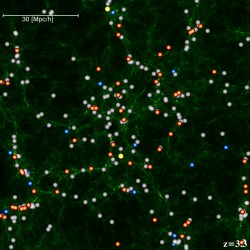
As dark energy increases, more and more galaxies will cross this cosmic horizon, invisible to us forever. And so, we can imagine a time in the far future, where the Cosmic Microwave Background Radiation has been stretched away until it’s undetectable. And eventually there will be a time when there will be no other galaxies visible in the night sky. Future astronomers will see a Universe without a cosmological history. There will be no way to know that there was ever a Big Bang, that there was ever a large scale structure to the Universe.
So how long will this be? According to Dr. Lawrence Krauss and Robert J. Scherrer, in as soon as 100 billion years, there will be no way to see other galaxies and calculate their velocity away from us. That sounds like a long time, but there are red dwarf stars that could live for more than a trillion years. We will have lost our history forever.
Cherish and make the most of these next hundred billion years. Keep our history alive and remember to tell our great great grandchildren and their robotic companions the tales of a time when we knew about the Big Bang.
What about you? What would you go see if you could witness any astronomical event in the history of the universe?
Planck’s Cosmic Map Reveals Universe Older, Expanding More Slowly
Like archaeologists sifting through the dust of ancient civilizations, scientists with the ESA Planck mission today showed a map of the oldest light in the Universe. The first cosmology results of the mission suggest our Universe is slightly older and expanding more slowly than previously thought.
Planck’s new estimate for the age of the Universe is 13.82 billion years.
The map also appears to show more matter and dark matter and less dark energy, a hypothetical force that is causing an expansion of the Universe.
“We are measuring the oldest light in the Universe, the cosmic microwave background,” says Paul Hertz, director of astrophysics with NASA. “It is the most sensitive and detailed map ever. It’s like going from standard television to a new high definition screen. The new details have become crystal clear.”
Overall, the cosmic background radiation, the afterglow of the Universe’s birth, is smooth and uniform. The map, however, provides a glimpse of the tiny temperature fluctuations that were imprinted on the sky when the Universe was just 370,000 years old. Scientists believe the map reveals a fossil, an imprint, of the state of the Universe just 10 nano-nano-nano-nano seconds after the Big Bang; just a tiny fraction of the time it took to read that sentence. The splotches in the Planck map represent the seeds from which the stars and galaxies formed.
The colors in the map represent different temperatures; red for warmer, blue for cooler. The temperature differences being only 1/100 millionth of a degree. “The contrast on the map has been turned way up,” says Charles Lawrence, the US project scientist for Planck at NASA’s Jet Propulsion Laboratory in Pasadena, Calif.
Planck, launched in 2009 from the Guiana Space Center in French Guiana, is a European Space Agency mission with significant contribution from NASA. The two-ton spacecraft gathers the ancient glow of the Universe’s beginning from a vantage more than 1 million miles from Earth.
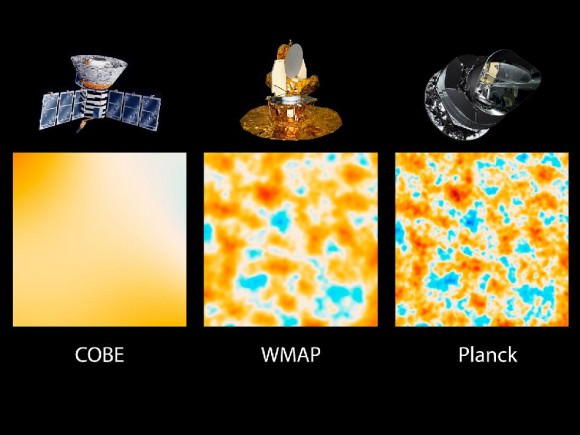
This is not the first map produced by Planck. In 2010, Planck produced an all-sky radiation map. Scientists, using supercomputers, have removed not only the bright emissions from foreground sources, like the Milky Way, but also stray light from the satellite itself.
As the light travels, matter scattered throughout the Universe with its associated gravity subtly bends and absorbs the light, “making it wiggle to and fro,” said Martin White, a Planck project scientist with the University of California, Berkeley and the Lawrence Berkeley National Laboratory.
“The Planck map shows the impact of all matter back to the edge of the Universe,” says White. “It’s not just a pretty picture. Our theories on how matter forms and how the Universe formed match spectacularly to this new data.”
“This is a treasury of scientific data,” said Krzysztof Gorski, a member of the Planck team with JPL. “We are very excited with the results. We find an early Universe that is considerably less rigged and more random than other, more complex models. We think they’ll be facing a dead-end.”
An artists animation depicting the “life” of a photon, or a particle light, as it travels across space and time from the beginning of the Universe to the detectors of the Planck telescope. Credit: NASA
Planck scientists believe the new data should help scientists refine many of the theories proposed by cosmologists that the Universe underwent a sudden and rapid inflation.
Super Good at Collecting Data, Massive Science Balloon Breaks Records
Super-TIGER prepares for launch from Antarctica.
NASA’s Super-TIGER science balloon landed Friday at a frigid and remote base in Antarctica after setting two duration records while gathering data about cosmic rays. There’s so much data that it will take scientists about two years to analyze, according to NASA.
Launched December 8, 2012 from the Long Duration Balloon site near McMurdo Station in Antarctica, the Super Trans-Iron Galactic Element Recorder balloon spent 55 days, 1 hour and 34 minutes aloft, shattering records previously set in 2009 by another NASA balloon for longest flight by a balloon of its size. The 39-million cubic foot balloon, spent most of its time cruising four times higher than commercial airlines at about 127,000 feet (almost 39 kilometers). The instrument is managed by Washington University in St. Louis, Missouri.
“Scientific balloons give scientists the ability to gather critical science data for a long duration at a very low relative cost,” said Vernon Jones, NASA’s Balloon Program scientist, in the press release. “Super-TIGER is scientific ballooning at its best.”
Super-TIGER measured rare heavy elements, such as iron, as they bombarded Earth from the Milky Way. The instrument detected about 50 million of these high-energy cosmic rays. Scientists hope the data from the mission will help understand where the energetic nuclei are produced and how they achieve such high energies.
NASA had three long-duration balloon missions in the summer skies of Antarctica. SuperTIGER was joined by BLAST and EBEX. All three balloons launched from the site near McMurdo Station in December. BLAST, or Balloon Borne Large Aperture Submillimeter Telescope launched Christmas Day and measured the polarized dust in star-forming regions helping astronomers determine if magnetic fields are a dominant force over turbulence in star-forming regions of the galaxy. BLAST’s mission lasted just over 16 days.
EBEX, the heaviest scientific payload borne aloft by a NASA balloon, measures cosmic microwave background radiation. The mission lasted 25 days and reached altitudes of 118,000 feet (or 36 kilometers).
Antarctica, it turns out, is ideal for these types of long-duration balloon missions with sparse populations and anticyclonic (east to west, counter-clockwise in the southern hemisphere) wind patterns in the stratosphere.
Source: NASA
Planck Unveils the Wonders of the Universe
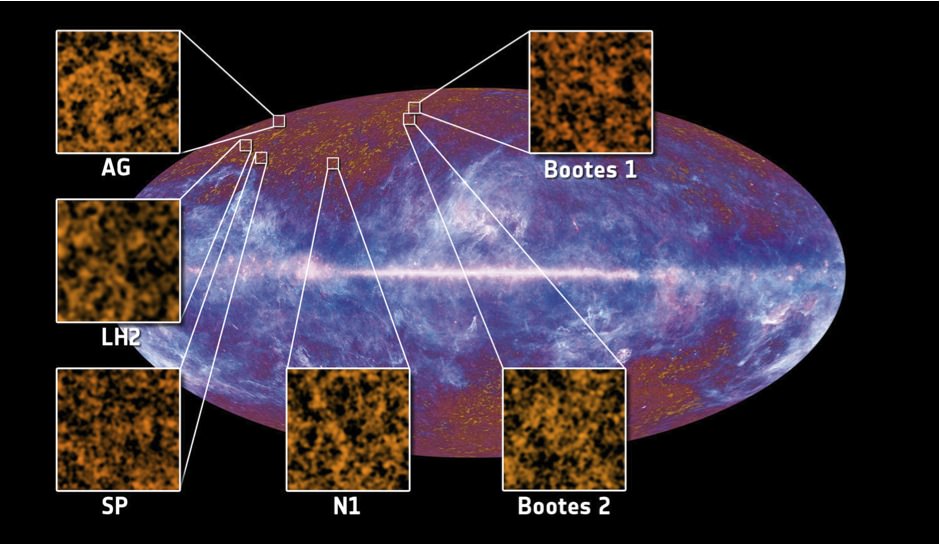
[/caption]
The mission began on 13th August 2009 with a goal to image the echo’s of the birth of the Universe, the cosmic background radiation. But scientists working on the European Space Agency’s (ESA) Planck mission got more than they bargained for making ground breaking discoveries and shedding light on old mysteries. By studying light from the far reaches of the Universe, Planck has to look through the rest of the Universe first and it was during this, that the incredible discoveries were made.
The crazy thing about looking at the far reaches of the Universe is that we actually look back in time as it takes billions of years for the light to reach us here on Earth. This enables astronomers to look back in time and study the evolution of the Universe almost back to the Big Bang itself. Amongst the discoveries was evidence for an otherwise invisible population of galaxies that seem to be shrouded in dust billions of years in the past. Star formation rates in these galaxies seem to be happening at an incredible pace, some 10-1000 times higher than we see in our own Milky Way galaxy today. Joanna Dunkley, of Oxford University, said “Planck’s measurements of these distant galaxies are shedding new light on when and where ancient stars formed in the early universe”.
One of the challenges of getting a clear view of these galaxies though has been removing the so called ‘anomalous microwave emission’ (AME) foreground haze. This annoying and poorly understood interference, which is thought to originate in our own Galaxy, has only just been pierced through with Planck’s instruments. But in doing so, clues to its nature have been unveiled. It seems that the AME is coming from dust grains in our Galaxy spinning several tens of billions of times per second, perhaps from collisions with incoming faster-moving atoms or from ultra-violet radiation. Planck was able to ‘remove’ the foreground microwave haze, leaving the distant galaxies in perfect view and the cosmic background radiation untouched.
Its also the ideal instrument to detect very cold matter in the form of dust in our Galaxy and beyond, thanks to its broad wavelength coverage. During its study, it detected over 900 clumps of cold dark dust clouds which are thought to represent the first stages of star birth. By studying a number of nearby galaxies within a few billion light years, the study shows that some of them contain much more cold dust than previously thought. Dr David Clements from Imperial College London says “Planck will help us to build a ladder connecting our Milky Way to the faint, distant galaxies and uncovering the evolution of dusty, star forming galaxies throughout cosmic history.”
These results make Planck a roaring success but it doesn’t stop there. Other results just published include data on galaxy clusters revealing them silhouetted against the cosmic microwave background. These clusters contain thousands of individual galaxies gravitational bound together into gigantic strings and loops.
The Planck mission, which was in development for 15 years is already providing some ground breaking science in its first few years of operation and its exciting to wonder what we will see from it in the years that lie ahead.
Mark Thompson is a writer and the astronomy presenter on the BBC One Show. See his website, The People’s Astronomer, and you can follow him on Twitter, @PeoplesAstro
How Many Stars are There in the Milky Way?

When you look up into the night sky, it seems like you can see a lot of stars. There are about 2,500 stars visible to the naked eye at any one point in time on the Earth, and 5,800-8,000 total visible stars (i.e. that can be spotted with the aid of binoculars or a telescope). But this is a very tiny fraction of the stars the Milky Way is thought to have!
So the question is, then, exactly how many stars are in the Milky Way Galaxy? Astronomers estimate that there are 100 billion to 400 billion stars contained within our galaxy, though some estimate claim there may be as many as a trillion. The reason for the disparity is because we have a hard time viewing the galaxy, and there’s only so many stars we can be sure are there.
Structure of the Milky Way:
Why can we only see so few of these stars? Well, for starters, our Solar System is located within the disk of the Milky Way, which is a barred spiral galaxy approximately 100,000 light years across. In addition, we are about 30,000 light years from the galactic center, which means there is a lot of distance – and a LOT of stars – between us and the other side of the galaxy.
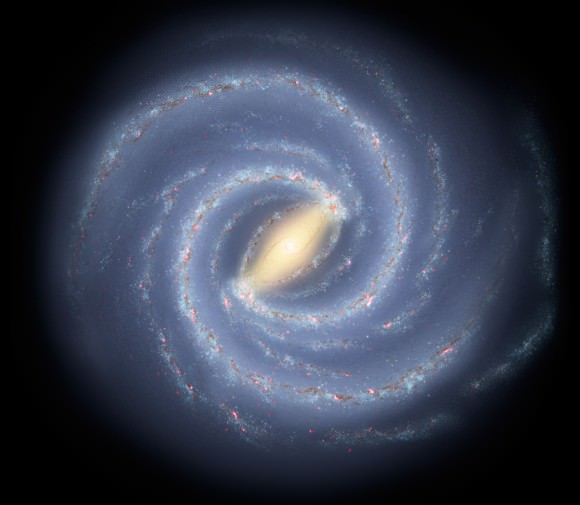
To complicate matter further, when astronomers look out at all of these stars, even closer ones that are relatively bright can be washed out by the light of brighter stars behind them. And then there are the faint stars that are at a significant distance from us, but which elude conventional detection because their light source is drowned out by brighter stars or star clusters in their vicinity.
The furthest stars that you can see with your naked eye (with a couple of exceptions) are about 1000 light years away. There are quite a few bright stars in the Milky Way, but clouds of dust and gas – especially those that lie at the galactic center – block visible light. This cloud, which appears as a dim glowing band arching across the night sky – is where our galaxy gets the “milky” in its name from.
It is also the reason why we can only really see the stars in our vicinity, and why those on the other side of the galaxy are hidden from us. To put it all in perspective, imagine you are standing in a very large, very crowded room, and are stuck in the far corner. If someone were to ask you, “how many people are there in here?”, you would have a hard time giving them an accurate figure.
Now imagine that someone brings in a smoke machine and begins filling the center of the room with a thick haze. Not only does it become difficult to see clearly more than a few meters in front of you, but objects on the other side of the room are entirely obscured. Basically, your inability to rise above the crowd and count heads means that you are stuck either making guesses, or estimating based on those that you can see.
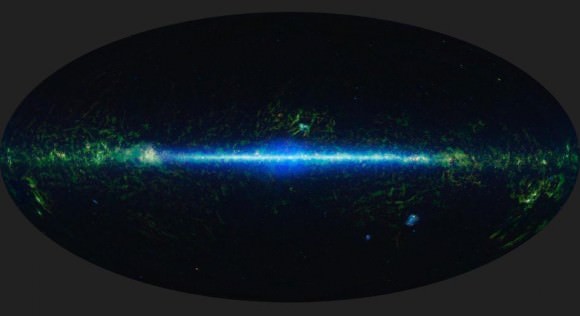
Imaging Methods:
Infrared (heat-sensitive) cameras like the Cosmic Background Explorer (aka. COBE) can see through the gas and dust because infrared light travels through it. And there’s also the Spitzer Space Telescope, an infrared space observatory launched by NASA in 2003; the Wide-field Infrared Survey Explorer (WISE), deployed in 2009; and the Herschel Space Observatory, a European Space Agency mission with important NASA participation.
All of these telescopes have been deployed over the past few years for the purpose of examining the universe in the infrared wavelength, so that astronomers will be able to detect stars that might have otherwise gone unnoticed. To give you a sense of what this might look like, check out the infrared image below, which was taken by COBE on Jan. 30th, 2000.
However, given that we still can’t seem them all, astronomers are forced to calculate the likely number of stars in the Milky Way based on a number of observable phenomena. They begin by observing the orbit of stars in the Milky Way’s disk to obtain the orbital velocity and rotational period of the Milky Way itself.
Estimates:
From what they have observed, astronomers have estimated that the galaxy’s rotational period (i.e. how long it takes to complete a single rotation) is apparently 225-250 million years at the position of the Sun. This means that the Milky Way as a whole is moving at a velocity of approximately 600 km per second, with respect to extragalactic frames of reference.
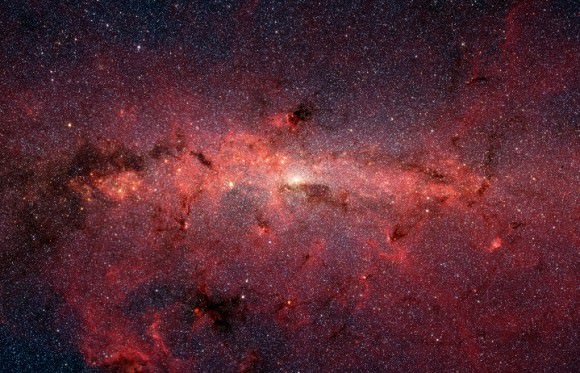
Then, after determining the mass (and subtracting out the halo of dark matter that makes up over 90% of the mass of the Milky Way), astronomers use surveys of the masses and types of stars in the galaxy to come up with an average mass. From all of this, they have obtained the estimate of 200-400 billion stars, though (as stated already) some believe there’s more.
Someday, our imaging techniques may become sophisticated enough that are able to spot every single star through the dust and particles that permeate our galaxy. Or perhaps will be able to send out space probes that will be able to take pictures of the Milky Way from Galactic north – i.e. the spot directly above the center of the Milky Way.
Until that time, estimates and a great deal of math are our only recourse for knowing exactly how crowded our local neighborhood is!
We have written many great articles on the Milky Way here at Universe Today. For example, here are 10 Facts About the Milky Way, as well as articles that answer other important questions.
These include How Big Is The Milky Way?, What is the Milky Way?, and Why Is Our Galaxy Called the Milky Way?
Astronomy Cast did a podcast all about the Milky Way, and the Students for the Exploration and Development of Space (SEDS) have plenty of information about the Milky Way here.
And if you’re up for counting a few of the stars, check out this mosaic from NASA’s Astronomy Picture of the Day. For a more in-depth explanation on the subject, go to How the Milky Way Galaxy Works.



